Digging bomb shelters sounds miserable and can’t be happy work. There’s the dark, dank, underground drudgery, and then there’s, well, the threat that the bombs will arrive before the job is finished.
But on a typical work day in 1941 workers in Cologne, Germany unearthed something that surely must have brightened their day: one of the largest, best preserved Roman mosaics in Europe. In fact, the floor mosaic was so outstanding that archaeologists left it right where it was, and the Roman-Germanic Museum (Römisch-Germanisches Museum) was built around it.
Like most great rivers, the Rhine was a natural conduit for explorers, adventurers, and ultimately, invaders. In 50 A.D. land-hungry Romans established a regional capital there, and roughly two centuries later, a member of the nobility added this incredible mosaic floor to their villa. Dionysus, the god of the grape harvest is the star of the show, and gives the 1800 year-old mosaic its name.
Mosaics are beautiful works of art, but they’re also appreciated by historians for the insights they provide into daily Roman life: clothing, food, tools, weapons, sports, farming, hunting, flora and fauna are carefully preserved in stone – all one million pieces of it.
The artist included vases of colorful flowers, lions, tigers, and birds. I particularly liked the two parakeets pulling a chariot. The message escapes me, but it’s an attention-getter. And honestly, nothing perks up a mosaic like a few nude gods and goddesses cavorting about.
I’ve always had an appreciation for mosaics. It must take a spectacular artistic talent to create a work of this complexity. And just how do you think they kept those million tiny pieces of rock organized?
The Dionysus Mosaic is the centerpiece of the museum, but it also has an excellent collection of glassware, as well as thousands of other everyday items that will give you a real feel for Roman colonial life in the far reaches of the empire. If you visit Cologne, don’t miss the Roman-Germanic Museum.
Happy Trails,
James & Terri
Last Updated September 6, 2023
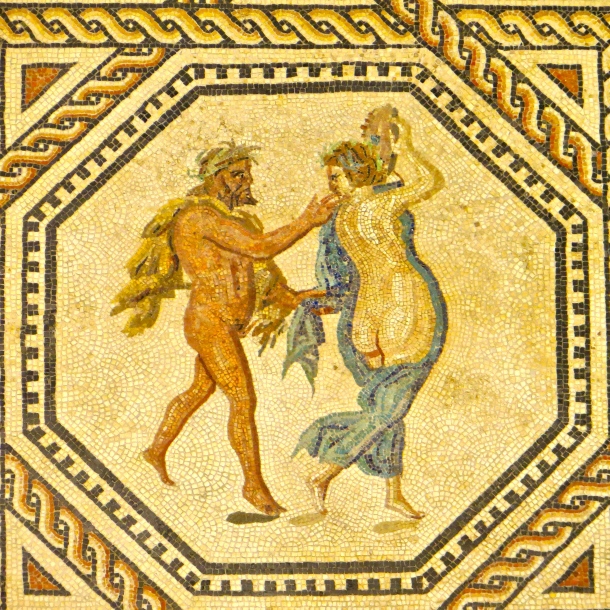

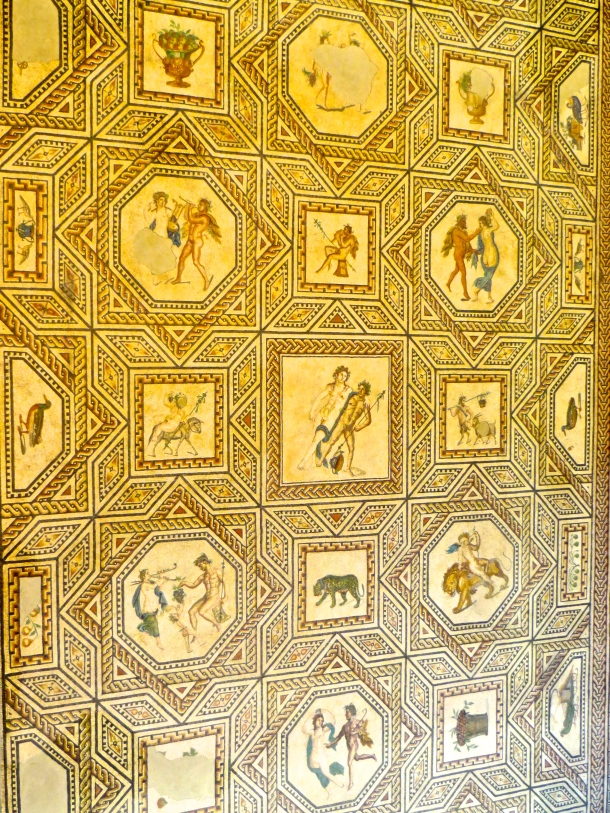
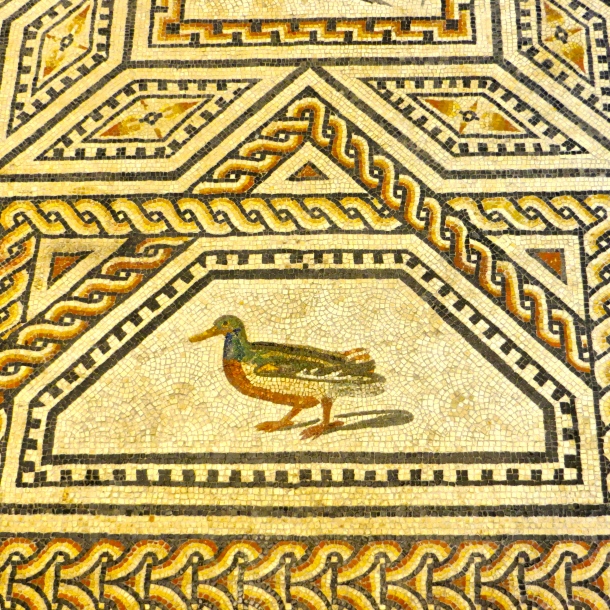
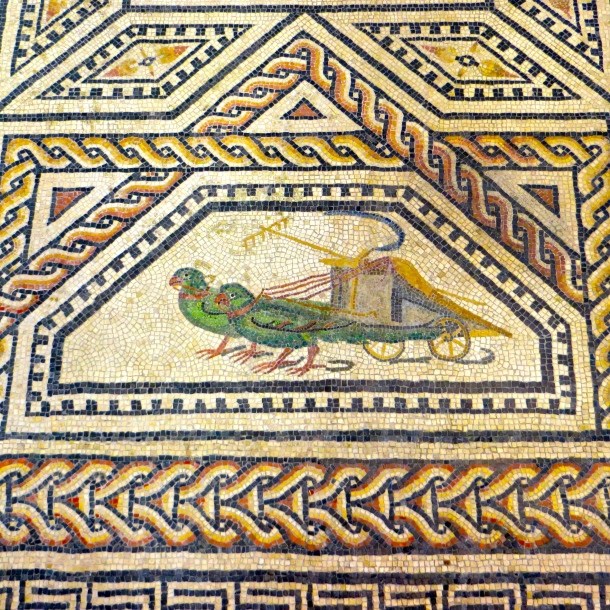
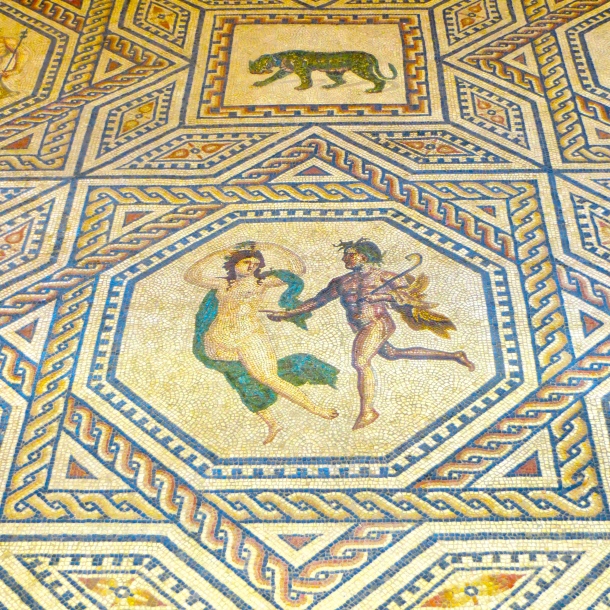
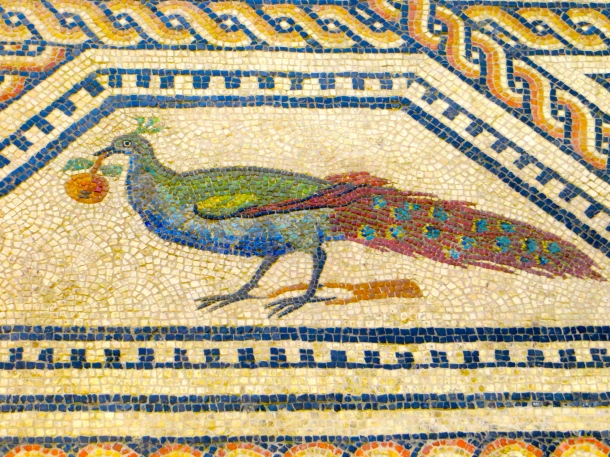

Oooooo! Just like in Cyprus! So beautiful and so intricate. I’m always blown away by the amount of work/care/patience/attention that must go into these creations. Imagine living in a house where you walked over those floors every day! Thanks for this delightful reminder, and addition to our experience of Roman mosaic floors.
Alison
I haven’t seen the mosaics in Cyprus Alison, but have seen a few scattered around the Med. This one is particularly well preserved and is one of my favorites. The level of detail is impressive, and I love the playful feel of the whole mosaic. Many of the pieces are pea-sized and smaller, so it’s survival is astounding. ~James
of course i loved seeing these amazing mosaics; can you imagine what it would be like to be digging and strike a jackpot like this?!
i wish i could step into the scene and back to the time when the artisans were piecing all of that together …. they surely loved their work…
Truthfully Lisa, the workers were probably more excited about having a break from digging. 😉 It’s interesting to think about differences in art from culture to culture. For instance, I can’t remember of any mosaic works from the Mesoamericans. My memory is that most of their stone artistry tends to me large and massive. Interesting because working with small stones must be much easier than huge boulders. Do you know of mosaics from any of the Central and South American cultures? ~James
i would certainly prefer to work with small stones than with boulders! as for mosaics in the preColumbian cultures – hmmmm. i don’t know of any mosaics in the americas, but i will probably be visiting a few museums in the next few weeks and will ask..
And indeed Cologne’s name comes from its role as an ancient Roman settlement: it’s name means Colony from Colonia Claudia Ara Agrippinensium. Provence in France gets its name in a similar way, as the first province outside Italy of the Roman Empire.
Don’t miss Aachen while you’re in the area: the city of Charlemagne.
I wasn’t aware of the origin of Provence Alastair. I didn’t say much about the museum in this post, but if you want a look at daily Roman life, this is the place. It’s interesting to think about Roman colonial life. I’m sure that when the colony is first established, the residents and officials felt like they’d been assigned to Mars. But obviously, as the colony matured, creature comforts from home filtered in. ~James
I’m a big fan of mosaics, too. Will be revisiting the ones in Ravenna in a couple of days. Have you seen the wonderful ones – Roman and Byzantine – on Sicily?
BTW, there is actually a place in Venice where you can learn the techniques: http://www.orsoni.com/default.asp?pc=008001000000002
Sicily is on our list Kathy, and in fact, we seriously considered visiting on our last trip, but decided to do it later. You’re the second person that’s mentioned it, so we’ve moved it up on our list. The mosaic workshop looks fun. The day we visited the Cologne museum there was a school group visiting, and the museum had a small mosaic project area in back for the kids. If the noise was an indicator, they were having a wonderful time. I wanted to join them. Enjoy Ravenna. ~James
I always think it a shame that mosaics are removed to museums, how clever to build a museum around an original location.
The thing that makes me most curious about this mosaic Andrew is how it was buried quickly enough to be so well preserved. The level of detail is amazing, and there are only a few small areas of missing stone. ~James
Being so close to the river, it could have been a flood event?
Good suggestion Andrew. The museum is close to the river today, and in Roman times could have been closer. ~James
Such amazing artistry. I can’t even begin to imagine all of the work that went into creating something so complex.
I agree Laura. The scale isn’t obvious in most of these photos Laura, but some of the birds are constructed from smaller than pea-size stones. I still have a difficult time imagining how it was so well preserved. The Romans built things to last, but there had to be some luck involved as well. ~James
Amazing! What a feeling to work on the day the art was found!
I hope the workmen felt a bit of pride for their grueling labors Vilma. This discovery is like finding a Rembrandt at the flea market. ~James
What a good analogy!
Mosaics have always fascinated me. The work, the talent, the patience.
One new elementary school I attended had a huge wall mosaic installed. I now only recall powder blues and pinks but that was the last one I’ve come across.
Were I an artist Tess, I think that the permanence of mosaics would appeal to me. Even when mistreated, they seem to survive better than most art forms. The Romans were all about the long term view and their mosaics make this point well. Imagine having even a small part of this mosaic on your floor. ~James
*nods*
Such elaborate, artistic mosaics, and they appear to be better preserved than those we saw in Sicily and Pompeii. As usual, your photos are amazing. You whet our appetites for Germany! – Mike
Thanks Mike. We lived in Berlin for a few months and had a chance to explore and appreciate the city. But before this trip, I felt that I hadn’t taken the time to fully appreciate the other parts of Germany. The country has a rich history (and not just WWII and the Nazis), and played a pivotal role in European history. I’m sure that you would enjoy some time there. ~James
GORGEOUS !!! I agree with you about mosaics, James – they’re simply breathtaking, even when worn down and with bits missing. I’m fairly astonished, though, that the digging of an air-raid shelter was stopped by this one, no matter how wonderful: I would’ve expected the urgency of the situation to overcome all scruples. Thank all the gods it didn’t !!!
In our travels on this trip M-R we saw numerous examples of the Nazis going out of their way to preserve art and cultural icons. I don’t know what the official party policy was, nor the true motivation, but the Nazis seem to have taken an interest in preservation of art. And if preservation was the goal, I’m sure the Nazis weren’t above sacrificing a few German citizens to get what they wanted. Maybe someone out there with more info will chime in on this, because I’d like to know more about it. ~James
Thanks for posting such amazing pieces of art!
Thanks Bertie. In addition to being wonderful art, this mosaic is fun. I’m sure that there’s lots of mythological symbolism that I’m missing, but I can look at the work and imagine how enjoyable it would be to have it in my home (yeah, fat chance). ~James
Stunning! I particularly enjoyed the birds. So colorful, and really interesting.
I agree Pam. I particularly like the peacock with all its detailed colors. And remember that it’s 1800 years old. Amazing. ~James
So interesting! I wish I had seen this when I visited Cologne — next time! Thanks for the beautiful post, Terri and James! Cheers — Steph
This museum has a wonderful collection Steph, and is worth a visit. We had a nice visit to Cologne, and were surprised at all there was to do. The city doesn’t get much publicity as a tourist hot spot, but we were very glad we visited. ~James
Sarah does love mosaic and when I showed her your post it proved no exception!
Thanks Chris. As I said, I’ve always been partial to mosaics as an art form. It requires an interesting combination of brut force shaping the stones, and at the same time, and incredibly patient hand crafting the details. ~James
These are beautiful glad I could see them
Joyce, I take it from you comment that things are going well on your end. I’m glad you could see the photos as well, and type a comment. Hang in there. Love, JH
I do like the glimpses into everyday life that the historians must be thrilled about learning, but I, too, have that burning question: how’d they keep all those pieces in order!!! I’m amazed at what is still preserved — seems as if this would have crumbled long ago. Love seeing this. Thanks for posting!
The Roman military was all about organization, and Roman mosaic artists had to be organized as well. I would love to know more about the process of creating a work this large and complex. And as to why it was preserved; in another comment, Andrew and I surmised how it managed to survive. I believe that it had to have been buried very quickly because if it had been exposed to the elements for very long (certainly 1800 years) it wouldn’t have been in shambles. Andrew suggested a flood, and because it was very close to the Rhine, I think this is a good guess. What we need is a forensic art historian. ~James
Oh to be the folks who happened upon this treasure! I think it is brilliant to build the museum around it. I think Andrew may be on to something with a flood causing the rapid covering to preserve them like that. I haven’t known much about mosaics until beginning to follow your blog last year. Now I am much more intrigued by the massive puzzles when we are traveling.
Over the years in our travels around the Med, we’ve seen lots of mosaics. I would love to have a photo record of them all, but unfortunately, my serious interest came later. I think that for Romans in the colonies, mosaics were a piece of home and a mark of civilization. In today’s dollars, I can’t imagine how much it would cost to create one. ~James
can you even image what a person would have to pay to have this type of craftsmanship in any building today. breath taking!
I agree Jolynn. A project like this must have taken a team of people to complete all the steps. Mass producing the small tiles would be a huge task in itself. I don’t know, but I suspect that creating works of this scale is a lost art. ~James
What an amazing piece of art and a brilliant story! I was blown away by the beautiful mosaics in a Pompeii and Herculaneum exhibition last year. Its great to see some more examples.
Thanks for the comment Sarah and for dropping by the blog. I visited Pompeii some years ago and remember the mosaics well. There’s nothing like a bit of lava to preserve a floor. And as a student of the classics, you know well that the Greeks were no slouches when it came to mosaics. I find them all interesting. ~James
Fascinating! I shared this with my history junky son; I’m sure he’ll love it too. 😉
There’s lots of Roman history in Cologne, and I’m sure that your son will enjoy it. I didn’t really emphasize it, but this is an outstanding museum for Roman history. In fact, it’s one of the best I’ve seen anywhere (including Rome). And who’da thunk – in Cologne, Germany. ~James
Aaron is a veritable encyclopedia of Roman history… I’ve sent it to him; now, getting him to read it. 😉
Stunning and amazing when you think of all those little, tiny pieces! Your photography made it come alive! How large is the total floor?
It’s about 25ft X 35ft Martha. Of course at the time, the owner probably wanted it in Roman units. Your question inspired me to look this up, and the measurements were “pes” and “digitus” or feet and fingers ( a finger being 1/16 of a foot). Now you’re ready for Jeopardy. ~James
What a shame I didn’t know about it when we were in Cologne.
I seem to remember you’re making a comment about the Locks of Love Bridge Marie. Well if you were on the bridge, you were really close to the museum. If you stand facing the Dom, the museum is behind and on the right. Next trip you should visit. It’s outstanding. ~James
I too love mosaics and hope someday to see some of these magnificent treasures that you both have seen in your travels.
Cologne isn’t on everyone’s visit list LuAnn, but we really enjoyed it. For Roman antiquities, this museum was wonderful, and of course the mosaic was outstanding. ~James
These are wonderful. Yes, reminded me of those in Cyprus and one in Faro, Portugal too. The parakeets appear to be pulling a cart with gardening or haymaking implements — a rake and a scythe. Or perhaps there is some other allusion. Wonder what artworks made for walking on will still be around in thousands of years time?
I went back and took a closer look Dorothy, and you’re right. I hadn’t figured out the rake or the scythe – haymaking for sure. But in my world, that has little to do with parakeets. I searched online for some connection, but was unsuccessful. Oh well. It’s interesting to see what Hollywood thinks will survive when they make a post-apocalypse movie. Tiles and mosaics have to be right up there. ~James
This was really interesting! I can only imagine how amazing this mosaic is if they built a museum around it. Love it 🙂
In addition Joanne, I focused on this beautiful mosaic, but the museum had a couple of others that were almost as big and also very well preserved. I was very surprised to discover a Roman museum in Cologne, but am certainly glad that I did. If you get to this part of the world, it’s a great stop. ~James
I’m coming around to mosaics more and more. (I think they may have been recently out of fashion when I was at That Age.) It’s definitely awe-inspiring to think about how they must have been put together.
If you ever find out anything about the chariot-pulling birds, let us know!
The parakeets and chariot are a mystery to me as well Bronwyn. I was hoping that some Roman history scholar would pick up some of my tags and provide some insight. This museum also had a wonderful mosaic of philosophers that was even more detailed than this one. But, I didn’t want to overdo it, and thought it best to dish out mosaics in small doses. ~James
Small doses. Yes! Probably right. You never know about the Roman History Scholar – they could be reading right now.
I’d never heard of this museum. The mosaics are fantastic. 🙂
I’m a big fan of Roman antiquities Jo, and may be biased, but this museum alone is worth making a trip to Cologne. They also have a number of other outstanding mosaics that I didn’t talk about. ~James
Beautiful! If I ever manage to get to Cologne, I’ll have to go there. Thanks for sharing!
Thanks for the comment Scott, and for dropping by the blog. It was a real surprise to find such a high quality Roman museum in Cologne. In fact, we spent a week in Cologne and really enjoyed the city. If you get to this part of the world, it’s definitely worth a visit. ~James
I have never heard of the Roman-Germanic Museum and its mosaics before now. Thank you for an informative post containing so many beautiful photographs. You are very fortunate to be able to travel around the world and experience so many wonderful places.
Thanks for the comment Ben, and for dropping by the blog. The Roman-Germanic Museum was unknown to me as well before my trip to Cologne. It’s an excellent museum in an unlikely place. ~James